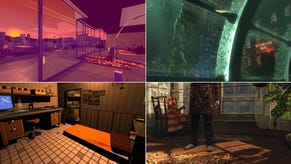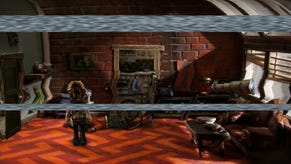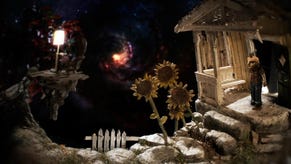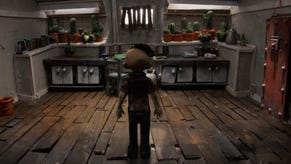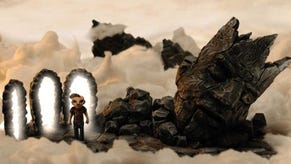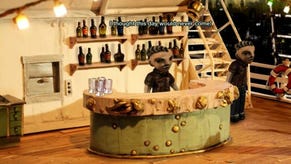Anders Gustafsson On The Dream Machine
The Dream Machine has already become one of my games of 2011 (despite being released in 2010, pedants). Its touching story and elegant point and click puzzles, combined with a gorgeous claymation and cardboard construction, puts it in a rare crowd: a great adventure game in the new millennium. Wanting to know a lot more about how it came about, and the thinking behind its design and narrative, I sent questions to one half of the development team, Anders Gustafsson. His engagingly detailed answers explore ideas of dream induction, the homogenisation of gaming, the role of voyeurism, and why non-interactivity isn't passivity.
RPS: Can you explain a bit about your background in gaming? The Dream Machine may be the first time some people have encountered Cockroach Inc., but you’ve been well regarded for a while, especially with the Gateway games.
Anders Gustafsson: I’ve been doing games for quite a while now. I started getting curious about making games back at the animations school I was attending. This might’ve been in 98-99. A fellow student showed me a couple of games he’d done in his spare time. Me, being mostly steeped in traditional hand-drawn animation, thought his games were the coolest things I’d ever seen. He submitted them to the Newgrounds scene and got a ton of feedback and collaboration contacts that way. And to me (sitting in the ass end of Sweden, isolated on an island in the middle of the Baltic Sea) that direct connection with likeminded people just seemed like such a beautiful thing.
Generously, he gave me the source file to one of his games, but I couldn’t program at that time and just thought code looked scary and off-putting. It took quite some time and lots of strong pots of coffee before it all started to make some kind of strange sense. Weeks later I presented my first game to him: a crappy two-player fighting game, featuring chickens. He was suitably impressed. Not so much by the game itself, I think, but by my persistence.
A few years later I was working at an ad agency in Copenhagen, and because they had a job drought I decided to use the time to improve my modest programming skills. I didn’t even know what an array was, but I’d heard the term and thought it sounded useful. So that was the first thing I studied up on. But just reading through a programming book was too dry, so I gave myself a concrete task and decided to build an adventure game engine from scratch, learning programming as I went along. Eventually I needed to test the functions of the engine, so I started implementing a little blocky character who could walk around in a very simple environment, pushing buttons etc. That was the start of Gateway.
RPS: The first Gateway is a smartly put together selection of room puzzles, with hints of something deeper. But it’s the second that brings in a lot of narrative – something that’s traditionally not associated with the room escape genre. Why does narrative play such an important role for you?
Anders Gustafsson: When I made the first Gateway game, I’d already made several attempts at creating adventure games. But they failed since I didn’t know what I was doing. I tried to tell a story, design puzzles, write code all at once, and it just didn’t gel. I would slave over a game for months, only to realize that I was basically beating a dead horse. It wasn’t fun to play, the story didn’t engage and the code was a useless mess. Admitting defeat, I salvaged what I could and moved on, only to fail again.
With the first Gateway game, I finally learned from previous mistakes and decided to limit my focus to one aspect of the game, namely the puzzles. I scrapped all fancy story concepts, admitting that designing puzzles was a hard enough challenge onto itself. What makes a puzzle interesting? How do you construct them? How does a player read them? Is the interactivity clear? Does it give enough feedback? Is it challenging? Is it fun to play?
By the time I started making Gateway 2 I felt I had some modest grasp of puzzle design, so I started layering bits of story onto the game. I’ve always felt that a story can be a zesty addition to a game. Not all of them, some games are better off without a developer-imposed narrative. The idea that story works in the direct opposition to gameplay struck me as dead wrong, even though I couldn’t articulate why I felt so at the time. I was curious to see if I could tell a story unobtrusively, without a clear split between the storytelling bits and the gameplay bits. Cutscenes just seemed like a clunky narrative device in a game. My ambition was for story and gameplay to coexist.
But that’s a tricky problem to solve and I still cringe when I revisit Gateway 2. The non-interactive videotapes that tell the back-story are a personal point of shame. I view them as failures, being just expository dialogue with no gameplay. But some of the puzzles tell the story without this disjointed split, and those were the parts I felt I wanted to develop more going forward.
RPS: The writing in both Gateway II, and especially The Dream Machine, is really outstanding in its honesty. What is your approach to storytelling, and to dialogue?
Anders Gustafsson: That’s a hard question to answer. I don’t really set out to write honestly or sincerely, but I’m glad that’s the way you experience it. Mostly the dialogue comes in chunks while I least expect it. As I try to fall asleep, the characters might start talking to each other in the back of my head and I just try to jot down what they said as quickly as possible. For some reason, I regard those snippets more highly than the ones I consciously wrote sitting in front of the computer. Usually they seem a bit more true and unforced. I’m not sure if I can recommend this method to anyone else. It’s certainly nothing I would attempt while on a tight deadline, since it’s very fickle. There’s a lot written about it, and it’s even a studied technique for problem solving. Google “dream induction” if you want to know more about it.
Originally I think it was a shamanistic concept, but the surrealists formalized it riffing off the works of Carl Jung. They thought the unconscious was a way of tapping the hidden creative potential of the psyche. Through techniques like sleep depravation, starvation and drugs, they sought to merge reality with dreams, turning it into Surreality. I don’t voluntarily practise these techniques myself, but I have problems sleeping and find that it’s better to occupy myself with work, rather than just lay in bed staring at the ceiling. That’s my approach to writing dialogue.
RPS: The other recurring element in your writing is emotion. Why do you think games are so afraid to attempt to write emotional stories? And how do you approach this while maintaining sincerity?
Anders Gustafsson: Eliciting an emotional response from the player is a large part of the fun for me. The same can be said for any game. They all try to trigger emotions, be it aggression, fear, pride etc. Personally, I think the business is too focused on eliciting the same emotional experience time after time. I love to berate games like Call of Honour for several reasons, but this is one of them. Call of Halo is just catering to the same emotional response. They’re designed to prod the reptilian part of our brain. It’s all aggression, all survival instincts. I would love it if they tried to stimulate other parts of the brain as well, like the limbic system or the cerebrum, where more complex emotions reside.
Don’t get me wrong, I like shooting my fellow man in the face just as much as the next guy, but the market is over-saturated to the point where I just can’t tell these games apart any more. They’re like the boy bands of the 90s. I see Medal of Duty as the gaming world's equivalent of McDonald’s or Brittney Spears. Catering to the masses through the lowest common denominator. Do I judge those who choose to indulge in those experiences? Not at all. Should we stop holding these games up as flagship staples of modern gaming greatness? Yes, we should.
RPS: Your games seem to show an interest in voyeurism. Can you discuss that a little?
Anders Gustafsson: In keeping with trying to elicit other emotions than the ones stemming from our reptilian brain, I started thinking about voyeurism as a sort of framing theme. I’m not sure how I ended up there, but most games touch upon voyeurism at a core level. They hinge a lot on observation and control. To “game” a system, for instance, is to gain control over it. You observe patterns, study components of mechanics and how they’re connected. If you keep it up long enough you eventually learn to control the system. By doing this, you gain a rewarding sense of empowerment. This is how we play games, consciously or unconsciously. The human brain is an excellent pattern recognizer. But it’s also a guilty pleasure, since once we gain full understanding of how a game works it stops being challenging, and therefore fun.
Voyeurism elicits conflicting emotions. That’s why I think it’s suitable for games. You can’t really just feel one way or another about it unless you’re lying to yourself. It’s morally reprehensible, sure, but also tickles the darker human nature associated with control, lust, shame etc. It’s something we’re socially conditioned not to indulge in, but our brain is hardwired to do anyway. It’s something people might feel uneasy or guilty about and that’s precisely why I wanted to go there. Conflicting emotions are challenging and therefore fun.
I want people to feel challenged on their own terms. I always thought that was the whole point of the Milgram experiments. That’s why I based a puzzle on it in Gateway 2. On the surface the Milgram experiments exposed the human animals as sycophantic sadists. But reading about what one person did to another makes me question what I would do in a similar situation. Would I do the same? And just by posing that question, I’m better equipped. At least now I’ve thought about it. When push comes to shove, I don’t know if I would electrocute my fellow man to death if I were told to with enough authority. I probably would. Wouldn’t you? But by posing the question I feel slightly better prepared.
Conflicting emotions are hard to deal with. We’re poorly equipped to deal with them because we try to avoid them at all cost. McDonald’s, Brittney Spears, Medal of Duty. It’s all comfort food. Cut-and-dry experiences designed to just thrill and delight, not to make us question anything about ourselves. I like Brittney, I think she’s swell. But as for my own contribution I want to pursue other things.
RPS: What is it about the point and click adventure that interests you? What does that form of gaming offer in particular?
Anders Gustafsson: There are a lot of reasons why I like it. It has a laid back nature: there’s no imposed time limit. The controls are quite simple: mouse only usually. It doesn’t require a lot of coordination. The environments are largely static so you don’t need expensive, powerful hardware to play. You don’t need the reflexes of a 12 year old on an amphetamine binge. In short, it’s a very inclusive genre.
I’m going off on another rant here, but I think gaming should be a democratic pleasure. But there’s a worrying trend to equate the word “player” with the word “consumer”. In order to play the latest games, you’re required to invest more money. Owning a TV and a console used to be enough, but now that’s arguably getting outdated. You also have to plunk out to get the latest plastic peripheral, or the motion sensitive controller, or god knows what comes next. “If you want to keep playing, you gotta keep paying.” As an old PC gamer, I saw what happened when the graphics card race fragmented the PC player base. It destroyed PC gaming, which has only recently begun resurfacing. The consoles seem to be heading in a similar direction. And it makes me want to go in the opposite way, frankly.
For some of the reasons stated above it’s a very good genre to tell stories in. The whole genre is about exploration and puzzle solving, which gives me ample opportunity to portion out pieces of story throughout. The current consensus seems to be that games and narrative are diametrically opposed and should never be mixed. The bulk of them state that games are about gameplay – actively consumed – and that narrative, in opposition, is passively consumed. To me, that model just sounds oversimplified and wrong. Some of the best games – Grim Fandango, Half-Life 2, Gabriel Knight, Loom, Portal, Monkey Island etc – just prove that time and again
If you view your audience as passively listening to your story, then you’re just plainly doing it wrong. Chuck Jordan has expressed this far more eloquently than I can, but storytelling has never been a one-way form of communication. It’s never been passively consumed. Passive isn't the opposite of non-interactive. You either actively listen to a story, or you’re not engaged at all. That’s why cutscenes usually are so grating to watch: they don’t engage.
What happens in the audiences’ heads is far more important than what I have to say as the narrator. I’ve humbly come to accept that after all my previous miserable failures. The audience should constantly be asking themselves what happens next, trying to connect the dots. If they don’t, I’ve failed. To watch a whodunit is to be actively engaged in the narrative. You observe and learn the individual components of the motives and opportunities. How it all ties together. It’s basically a game between them and the narrator. The goal is to figure out who’s guilty before it’s revealed to you – to “game” the system. If you’re watching, not thinking about who did it, being totally passive, then the storyteller has simply failed to engage.
RPS: What inspired the decision for the cardboard/clay design of The Dream Machine? Is it a medium you’ve worked in before?
Anders Gustafsson: Both Erik and me have backgrounds in traditional animation. That’s how we met, we where both attending the same animation school. After graduation Erik started his own animation studio with three of his friends. Their main focus was stop-motion, so by the time we started The Dream Machine he already had the equipment and the know-how.
It was his idea to make a hand-built game. I was reluctant at first because it just sounded too labour intensive, but he sat up all night making these little beautiful test sets to prove it could be done. And once I saw them I just fell in love. They just held such a world of potential in them. A lot of games are too homogenous and we felt we wanted to differentiate ourselves from that. We want to see games utilizing a wider pallet of expressions. We love Noby Noby Boy, Patapon, Rez, Grim Fandago, The Neverhood, The Dark Eye etc. An expression that hasn’t been beaten to a bloody pulp already. Is that too much to ask?
RPS: What were the reasons behind keeping the first chapter of TDM set so much in the real world?
Anders Gustafsson: Dramatic contrast mainly. If the whole game had been set in dreams, it wouldn’t feel as trippy as it does when you have contrasting points of comparison. Per the law of diminishing returns it would quickly loose its novelty. The first dream would feel trippy, the second would have less impact, the third would have no impact at all etc. It was also important for the player to get a sense of who Victor and Alicia are early on, and that would be harder if we placed them in an extraordinary setting. I think that’s where a lot of games go wrong. You learn a lot about a character by observing their everyday plight. It doesn’t have to be full on drama right off the bat. We wanted to calmly present the ambitions for this young couple without outside interference. And since their ambitions are non-exceptional (they’re trying to start a family in a new town) we couldn’t have fireworks going off at the same time.
Personally, I like a sense of the mundane in a game, because it’s so rarely utilized. I appreciate the efforts of David Cage and his team. I sound like an old codger, I know, but I just don’t get why 99% of all games have to be pre-pubescent power fantasies. That’s just comfort food. It’s McDonald’s.
RPS: Clearly you have three more chapters to make. But what’s next for Cockroach? Do you see yourselves pursuing the hand-made theme, or are there other plans afoot?
Anders Gustafsson: I can’t say too much about that. We’re working on a new game concept that we might do after The Dream Machine. What style we execute it in is largely dictated by the idea. Ideas have a will of their own which you have to listen to. Lately we’ve been getting more and more interested in the art of origami, which seems to coalesce with this new game. It takes place in the afterlife.
I don’t know how Erik feels, but I’d love to take a break from games once The Dream Machine is done. I work from my home and I usually get quite obsessive about these projects, which means I don’t go out nearly as much as I should. It would be nice to get out, hang with some friends. Perhaps they'll still recognize me?
RPS: Thanks for your time.
You can play the first chapter of The Dream Machine for free here.










